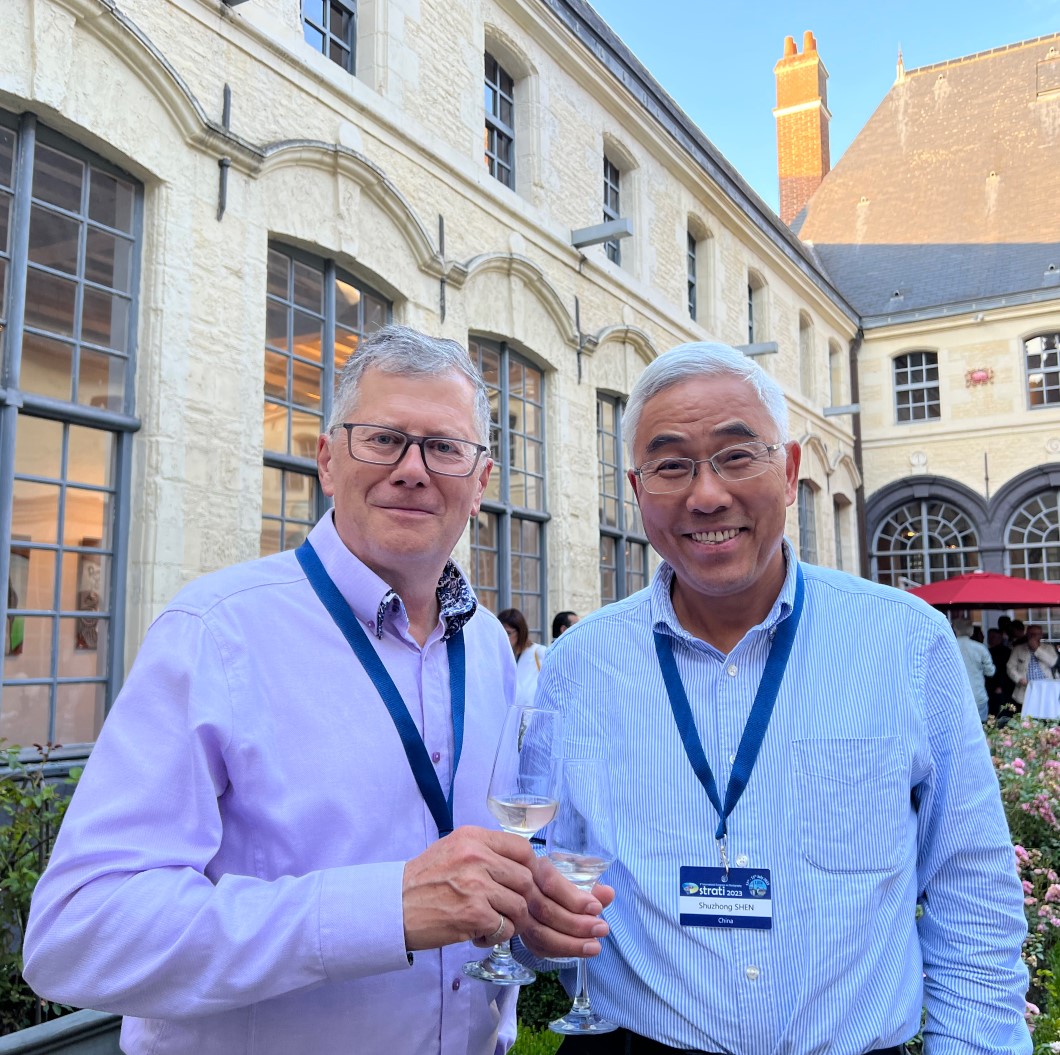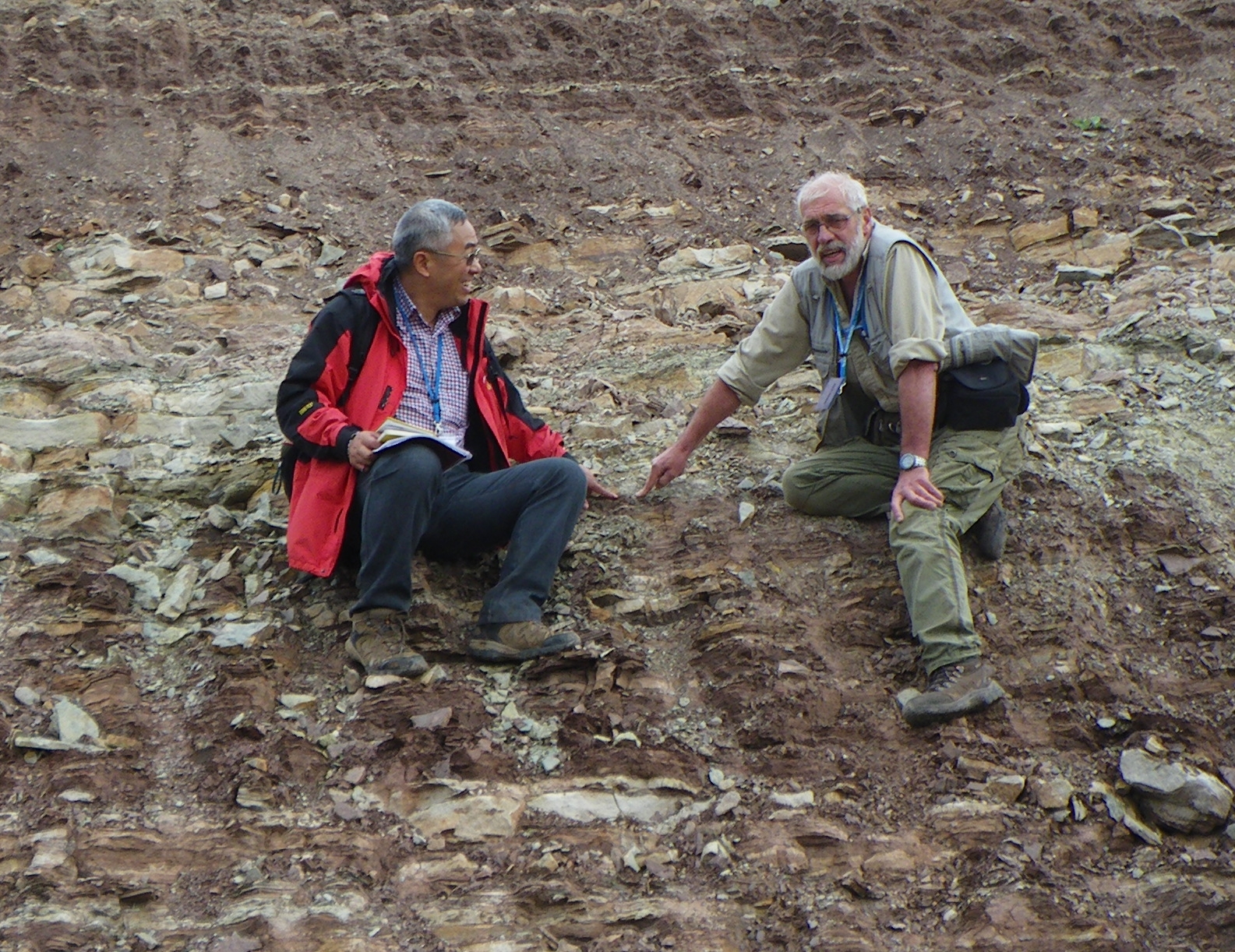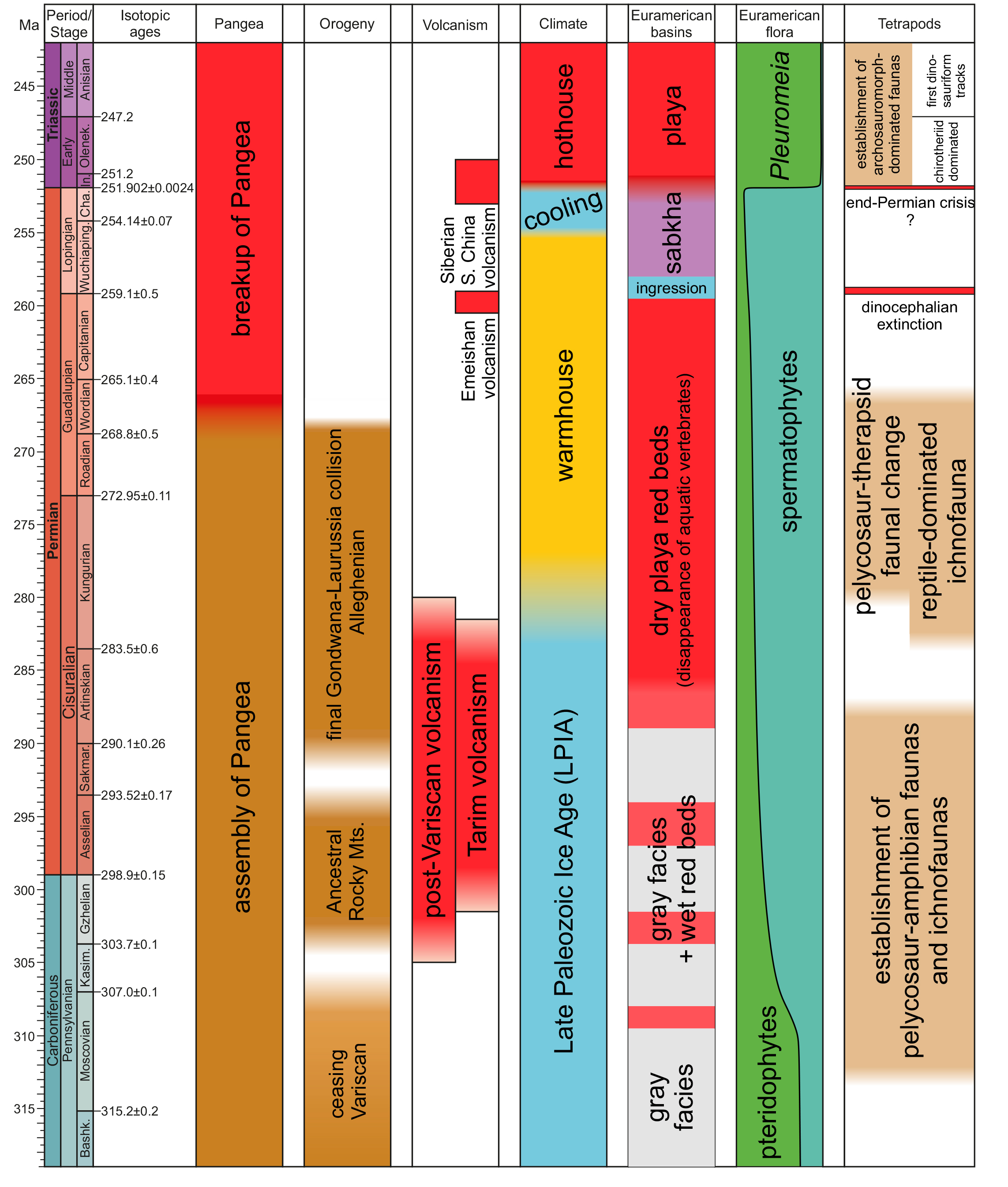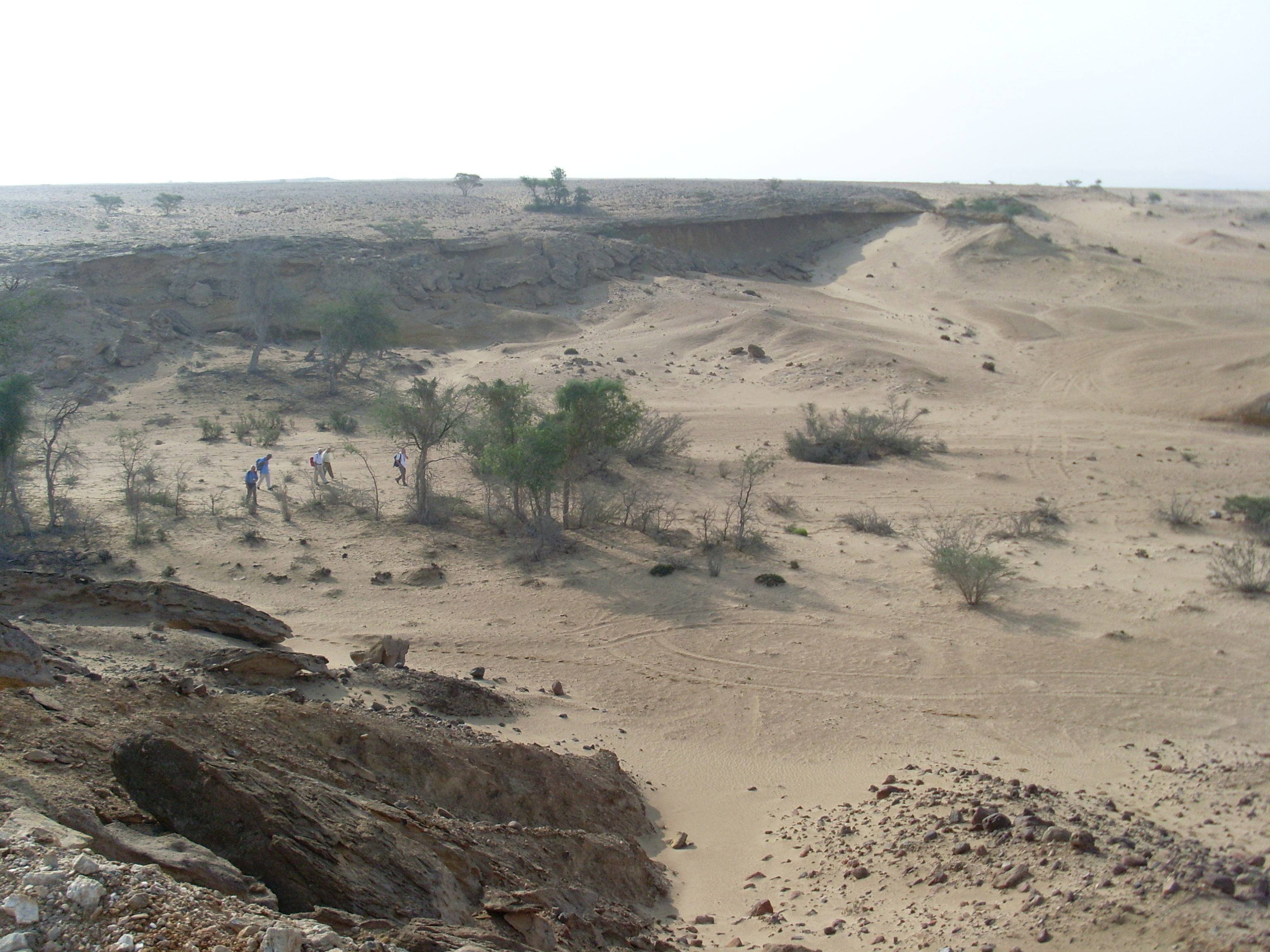Working Groups
- Base-Kungurian Working Group
- Base-Roadian Working Group
- Base-Wordian Working Group
- Correlation between marine and continental Carboniferous-Permian Transition Working Group
- Gondwana to Euramerica correlations Working Group
Base-Kungurian Working Group
Leader: Prof. Charles Henderson
The Kungurian Stage is the only stage that has not been ratified with a Global Stratotype Section and Point within the Permian System. In 2012 there was a general consensus regarding a GSSP level marked by the FO of Neostreptognathodus pnevi. Two sections were proposed including the Mechetlino section in Russia (Chernykh et al., 2012) and the Rockland section in Nevada, USA (Henderson et al., 2012). Additional work was published for the Mechetlino Section (Chernykh et al., 2020). However, the Mechetlino section is no longer available owing to scientific sanctions by the IUGS because of Russia’s invasion of Ukraine. It was announced in Permophiles 74 that SPS would move ahead with a GSSP proposal for the Rockland Section in Nevada (Angiolini et al., 2023). A working group has been formed and progress is occurring (Henderson, 2023; Henderson, 2024). The working group is charged with preparing and reviewing a proposal for the Rockland Section. The working group will also describe the Mechetlino section as a supplementary reference section and consider correlation into other regions including the nearby Carlin Canyon section, as well as other sections in SW USA (see Lucas et al., 2022 for example) and South China. The proposal will then be presented to SPS for voting.
Current plans include a field excursion to the site May 17-24, 2024 to collect fusulinid samples.
References
Angiolini, L., Beauchamp, B., Bratton, L., Fraser, B., Henderson, C., Synder, W. and Zanchi, A., 2023. The once and future quest: the Kungurian GSSP candidate at Rockland Section and SABS at Carlin Canyon, Nevada. Permophiles, n. 74, p. 37–41.
Chernykh, V.V., Chuvashov, B.I., Davydov, V.I. and Schmitz, M.D., 2012. Mechetlino Section: A candidate for the Global Stratotype and Point (GSSP) of the Kungurian Stage (Cisuralian, Lower Permian). Permophiles, n. 56, p. 21–34.
Chernykh, V.V., Kotlyar, G.V., Chuvashov, B.I., Kutygin, R.V., Filimonova, T.V., Sungatullina, G.M., Mizens, G.A.,Sungatullin, R.K., Isakova, T.N., Boiko, M.S., Ivanov, A.O., Nurgalieva, N. G., Balabanov, V.Y.P., Mychko, E.V., Garrev, B.I. and Batalin, G.A., 2020. Multidisciplinary study of the Mechetlino Quarry section (southern Urals, Russia) – The GSSP candidate for the base of the Kungurian Stage (Lower Permian). Palaeoworld, 29: 325–352.
Henderson, C.M., 2023. Working Group announcement and progress on the base-Kungurian GSSP proposal. Permophiles, n. 75, p. 8.
Henderson, C.M., 2024. Base-Kungurian GSSP Working Group progress. Permophiles, n. 76, p. 8-9.
Henderson, C.M., Wardlaw, B.R., Davydov, V.I., Schmitz, M.D, Schiappa, T.A., Tierney, K.E. and Shen, S.Z., 2012. Proposal for the base-Kungurian GSSP. Permophiles, n. 56, p. 8–21.
Lucas, S.G., Henderson, C.M., Barrick, J.E., Krainer, K., 2022. Conodonts and the correlation of the Lower Permian Yeso Group, New Mexico, USA. Stratigraphy, 19(2), p. 77-94.
Composition of the Kungurian Working Group
Chair: Charles M. Henderson (Department of Earth, Energy, and Environment, University of Calgary, Canada)
Current Members:
Lucia Angiolini (Universita degli Studi di Milano, Italy)
Benoit Beauchamp (Department of Earth, Energy, and Environment, University of Calgary)
Luke Bratton (Department of Earth, Energy, and Environment, University of Calgary)
Neil Griffis (USGS, Denver, Co., USA)
Hana Jurikova (University of St. Andrews, St. Andrews, UK)
Lorenzo Marchetti (Museum fur Naturkunde, Berlin, Germany)
Michael Read (Stephen F. Austin State University, USA)
Tamra Schiappa (Department of Geography, Geology and the Environment, Slippery Rock University, PA. USA)
Walter S. Snyder (Boise State University, ID., USA)
Kate Tierney (University of Iowa, USA)
Dongxun Yuan (School of Resources and Geosciences, China University of Mining and Technology, Xuzhou, China)
Base-Roadian Working Group
Leader: Prof. Charles Henderson
The Guadalupian Series (Middle Permian) consists of three stages (Roadian, Wordian and Capitanian in ascending order) that were ratified by IUGS in 2001. All three GSSPs were presented in a single proposal (Glenister et al., 1999), but detailed descriptions of these sections were not published in Episodes, as is the norm for ratified GSSPs. A group of researchers led by Shuzhong Shen investigated the three sections in the Guadalupe Mountains in order to provide additional correlation data and publish in Episodes. The Capitanian was published in Episodes in 2022 (Shen et al., 2022), but the other two boundaries proved to be more problematic. The problems and progress of the Roadian and Wordian can be seen in the presentation by Shuzhong Shen and Charles Henderson on October 24, 2023 (see link provided below) and in Permophiles 76 (Henderson and Shen, 2024; Henderson, 2024; Lucas, 2024). SPS voting members meeting on zoom in December 2023 decided that working groups would be established to investigate the Roadian and Wordian. Voting members agreed that the Roadian GSSP section is a good section, but opinions varied regarding the correlation potential of the chosen level, which is marked by the FO of Jinogondolella nankingensis. The working group is therefore charged to consider whether the boundary can remain at its current level or revised a few metres higher. The working group will also consider a Standard Auxiliary Boundary Stratotype section (SABS) at the Maweishan section in south China. Finally, a manuscript will be prepared that either proposes a new level or provides new details regarding the current GSSP level to be published in Episodes.
https://permian.stratigraphy.org/Interests/Shuzhong%20and%20Charles
References
Glenister, B.F., Wardlaw, B.R., Lambert, L.L., Spinosa, C., Bowring, S.A., Erwin, D.H., Menning, M., Wilde, G.L. 1999. Proposal of Guadalupian and component Roadian, Wordian and Capitanian Stages as international standards for the Middle Permian. Permophiles 34:3-11.
Henderson, C.M. 2024. The Permian Guadalupian stages: How collaborative science and conodonts can produce a workable chronostratigraphy. Permophiles 76:11-13.
Henderson, C.M., Shen, S.Z. 2024. Call to develop two new working groups: the base-Roadian GSSP Working Group and the base-Wordian GSSP Working Group. Permophiles, 76:8.
Lucas, S.G. 2024. The Permian Guadalupian stages: how politics and conodonts produced an unworkable chronostratigraphy. Permophiles, 76:9-11.
Shen, SZ, Yuan, DX, Henderson, C.M., Lambert, L.L., Zhang, YC, Erwin, D.H., Ramezani, J., Wang, XD, Zhang, H., Wu, Q., Wang, WQ., Hearst, J.M., Chen, J., Wang, Y., Qie, WK., Qi, YP., Wardlaw, B.R., 2022 accepted. The Global Stratotype Section and Point (GSSP) for the Capitanian Stage (Guadalupian, Middle Permian). Episodes, v. 45 (3): 309-331.
Composition of the Roadian Working Group
Chair: Charles M. Henderson (Department of Earth, Energy, and Environment, University of Calgary, Canada)
Vice-Chair: Shuzhong Shen (School of Earth Sciences and Engineering, Nanjing University, China)
Current Members:
Neil Griffis (USGS, Denver, Co., USA)
Hana Jurikova (University of St. Andrews, St. Andrews, UK)
Lance Lambert (University of Texas at San Antonio, USA)
Lorenzo Marchetti (Museum fur Naturkunde, Berlin, Germany)
Galina Nestell (University of Texas at Austin, USA)
Michael Read (Stephen F. Austin State University, USA)
Ausonio Ronchi (Universita di Pavia, Italy)
Michael Stephenson (Stephenson Geoscience Consulting, Nottingham, UK)
Dongxun Yuan (School of Resources and Geosciences, China University of Mining and Technology, China)
Quanfeng Zheng (Nanjing Institute of Geology and Palaeontology, China)

Base-Wordian Working Group
Leader: Prof. Shuzhong Shen
The Guadalupian Series (Middle Permian) and its constituted three stages (Roadian, Wordian and Capitanian in ascending order), as the international standard chronostratigraphcial units, were proposed by Glenister et al. (1992) and was formally agreed by the Subcommission on Permian Stratigraohy (SPS) (Jin et al., 1997). The base-Wordian GSSP at Getaway Ledge in the Guadalupe Mountains National Park, Texas defined by the First Appearance Datum (FAD) of the conodont Jinogondolella aserrata, was briefly described and proposed by Glenister et al. (1992, 1999), the SPS vote result was reported in Permophiles 35 (1999; p. 4), and the proposal was ratified by ICS and IUGS in 2001.
Subsequent researches (Yuan et al., 2021; Shen et al., 2020; also see comments by Lucas, 2004 and Henderson, 2024) revealed that the conodont marker to correlate the boundary by the FAD of Jinogondolella aserrata has not been found in the bed marked by the golden spike, but it first occurs in some unknown horizon in the underlying unfossiliferous Cherry Canyon Sandstone at the Getaway Ledge section. This makes the establishment of the FO of the species impossible in the short carbonate unit.
In December 2023, the SPS voting members unanimously reached the conclusion that the base-Wordian should be redefined (Henderson and Shen, 2024). A working group has thus been established to restudy the original GSSP and search new candidates for the base-Wordian GSSP if necessary.
References
Glenister, B. F., Boyd, D. W., Furnish, W. M., Grant, R. E., Harris, M. T., Kozur, H., Lambert, L. L., Nassichuk, W. W., Newell, N. D., Pray, L. C., Spinosa, C., Wardlaw, B. R., Wilde, G. L., Yancey, T. E. 1992. The Guadalupian: Proposed international standard for a Middle Permian series. International Geology Review 34(9):857-888.
Glenister, B.F., Wardlaw, B.R., Lambert, L.L., Spinosa, C., Bowring, S.A., Erwin, D.H., Menning, M., Wilde, G.L. 1999. Proposal of Guadalupian and component Roadian, Wordian and Capitanian Stages as international standards for the Middle Permian. Permophiles 34:3-11.
Henderson, C.M. 2024. The Permian Guadalupian stages: How collaborative science and conodonts can produce a workable chronostratigraphy. Permophiles 76:11-13.
Henderson, C.M., Shen, S.Z. 2024. Call to develop two new working groups: the base-Roadian GSSP Working Group and the base-Wordian GSSP Working Group. Permophiles, 76:8.
Jin, Y.G., Wardlaw, B.R., Glenister, B.F., Kotlyar, C.V. 1997. Permian chronostratigraphic subdivisions. Episodes 20(1):6-10.
Lucas, S.G. 2024. The Permian Guadalupian stages: how politics and conodonts produced an unworkable chronostratigraphy. Permophiles, 76:9-11.
Shen, S.Z., Yuan, D.X., Henderson, C.M., Wu, Q., Zhang, Y.C., Zhang, H., Mu, L., Ramezani, J., Wang, X.D., Lambert, L.L., Erwin, D.H., Hearst, J.M., Xiang, L., Chen, B., Fan, J.X., Wang, Y., Wang, W.Q., Qi, Y.P., Chen, J., Qie, W.K., Wang, T. T. 2020. Progress, problems and prospects: An overview of the Guadalupian Series of South China and North America. Earth-Science Reviews, 211:103412.
Yuan, D.X., Shen, S.Z., Henderson, C.M., Lambert, L.L., Hearst, J.M., Zhang, Y.C., Chen, J., Qie, W.K., Zhang, H., Wang, X.D., Qi, Y.P., Wu, Q. 2021. Reinvestigation of the Wordian-base GSSP section, West Texas, USA. Newsletters on Stratigraphy, 54(3):301-315.
Composition of the base-Wordian Working Group
Shuzhong Shen (Chair, School of Earth Sciences and Engineering, Nanjing University, China)
Members:
Lucia Angiolini (Milano University, Italy)
Charles Henderson (University of Calgary, Canada)
Jahan Ramezani (Department of Earth, Atmospheric, and Planetary Sciences, Massachusetts Institute of Technology, USA)
Qiong Wu (Southern Marine Science and Engineering Guangdong Laboratory, China)
Lance Lambert (The University of Texas at San Antonio, USA)
Spencer Lucas (New Mexico Museum of Natural History, USA)
Dongxun Yuan (School of Resources and Geosciences, China University of Mining and Technology, China)
Yichun Zhang (Nanjing Institute of Geology and Palaeontology, China)
Wenqian Wang (School of Earth Sciences and Engineering, Nanjing University, China)
Min Zhang (Institute of Geology and Geophysics, China)
Quanfeng Zheng (Nanjing Institute of Geology and Palaeontology, China)
Correlation between marine and continental Carboniferous-Permian Transition Working Group
Leader: Prof. Joerg Schneider
Dear Permian community,
As the former Vice-Chair of the Subcommission on Permian Stratigraphy (SPS) from 2012 to 2020, I would like to thank you for my election to this position in 2012. This provided me the chance in cooperation with the Chair Shuzhong Shen (Fig. 1) to set a focus of the work of our commission on the connection of nonmarine deposits, which are very wide spread during the sea level low stand of Late Palaeozoic Pangea, to the marine Standard Global Chronostratigraphic Scale (SGCS). Pushed forward by many colleagues I started to organize a corresponding working group. After some previous activity the first crucial step was done during a business meeting of the Subcommission on Carboniferous Stratigraphy (SCCS) and the SPS linked to the International Meeting on the “Carboniferous-Permian Transition” at the New Mexico Museum of Natural History and Science, Albuquerque, that was held in May 2013 and organized by Spencer G. Lucas (Lucas et al., 2013). During this meeting the chairs of the Subcommissions on Carboniferous and on Permian Stratigraphy, Barry Richards and Shuzhong Shen, agreed to constitute a formal Nonmarine-Marine Correlation Working Group (NMCG) between both subcommissions in order to obtain more man power (Schneider et al., 2014a,c).
As a kick-off for this working group, a Field Meeting on Carboniferous and Permian Nonmarine-Marine Correlation was held at the Technical University Bergakademie Freiberg in July 2014 in Germany, organized by Joerg W. Schneider, Olaf Elicki, Stanislav Opluštil, and Spencer G. Lucas (Elicki et al., 2014; Schneider et al., 2014a). About 70 participants from Western and Eastern Europe, North and South America, North and South Africa, and Asia joined this meeting. In September of the same year, a collaborative field work of the Sino-German Cooperation Group and a SPS workshop chaired by Shuzhong Shen, Joerg W. Schneider, Hans Kerp, and supported by the Vice Chair of the SCCS, Xiangdong Wang, was carried out in NW China. It focused on late Permian and Permian/Triassic boundary nonmarine-marine correlations. The fieldwork during these two weeks and the preceding four weeks of fieldwork of a Sino-German team (PhD students from Nanjing and Freiberg) in South and North China provided a wealth of samples around the nonmarine PT-boundary for conchostracan and fossil plant biostratigraphy, isotopic ages and geochemistry (e.g. Scholtze et al., 2017, 2020).
A first report on results and future tasks of the working group was given during the international “Kazan Golovkinsky Stratigraphic Meeting” held from the 20 to 23 of October 2014 at the Kazan Federal University, Russian Federation, Republic of Tatarstan (Schneider et al., 2014b). This meeting was dedicated to “Carboniferous and Permian Earth systems, stratigraphic events, biotic evolution, sedimentary basins and resources” (Nurgaliev et al., 2014). It was followed in August 2015 by the XVIII International Congress on the Carboniferous and Permian at the Kazan Federal University with 165 attendants from 33 countries, among them numerous members of the NMCG. As a result of the “Call for global cooperation” (Schneider & Lucas, 2015), 18 members of the NMCG presented a common compilation of nonmarine reference sections for the Carboniferous and the Permian at this congress. Very stimulating for the work of the NMCG have been the congress excursions to the marvelous and excellently investigated outcrops of fossiliferous marine-continental and purely continental middle Permian to early Triassic sediments on the banks of the rivers in the Vologda region as well as in the Volga and Kama Region of the East European platform (Arefiev et al., 2015; Nurgaliev et al.2015).
Earlier, in April 2015, the Moroccan members of the NMCG, Hafid Saber, Abdelouahed Lagnaoui, Abouchouaïb Belahmira and Abdelkbir Hminna, had organized the First International Congress on Continental Ichnology (ICCI-2015) at the University of El Jadida, Morocco, a bi-annual meeting that very much promoted since then tetrapod biostratigraphy of the late Palaeozoic and the Mesozoic (Saber et al., 2015; Lagnaoui et al., 2015). In 2015, the then chair of the Subcommission on Triassic Stratigraphy, Marco Balini, agreed to include the continental Triassic in the tasks of the NMCG. The years 2016 and 2017 were mainly devoted to research and a wealth of publications as reported by the working group members (Schneider et al. 2017). Some further research results on nonmarine Permian bio¬stratigraphy and biochronology were published in the volume on the Permian timescale edited by Lucas and Shen (2018). In 2018 and 2019, 18 members of the working group were busy on the internally so-called “monster manuscript,” a compilation of current methods of non-marine long-range biostratigraphy and of current data from 24 regions on Pangea (Schneider et al., 2020a,b). The results have been published in the special issue 29 of Palaeoworld, which summarized the contributions to and the results of the Second Golovkinsky Stratigraphic Meeting devoted to “Late Palaeozoic high-precision biostratigraphy, geochronology, climates and environments,” which took place at Kazan Federal University, Russia, in 2017 (Nurgaliev et al. 2020).
The international team of Schneider et al. (2020a) provides a concise up-to-date synthesis of nonmarine biostratigraphic methods suited for interregional and intercontinental correlations. Most importantly, these methods are calibrated with each other for the first time by cross correlations, and calibrated to the Standard Global Chronostratigraphical Scale by co-occurrences of continental and marine guide fossils as well as by using radioisotopic ages and multistratigraphic methods (Schneider et al., 2020a, fig. 3). This contribution shows the progress of the last two decades, and provides a solid basis for further research, which should focus on the following tasks of the SPS and the NMCG as already discussed in Permophiles 68 (Schneider et al., 2020b; partially repeated here), and during the 19th International Congress on the Carboniferous and Permian in Cologne, August 2019 (Herbig, 2020): First, the solution of the middle Permian problem. Guadalupian nonmarine deposits are very limited and scattered in Euramerica and provide so far some biostratigraphic correlations based on conchostracans and tetrapod footprints, only. Additionally, volcanites suitable for radioisotopic age determina¬tions are nearly missing in this interval, even in marine deposits. Only the South African Karoo basin provides good nonmarine biostratigraphic records for the Guadalupian, particularly for tetrapod body fossils, and can be correlated with the SGCS using radioisotopic ages (e.g. Day et al., 2018). The correlation of the Karoo tetra¬pod zones with those of the East European platform in Russia, as proposed in Schneider et al. (2020a), will possibly be improved by isotopic ages from the latter basin. The second and most challenging future task for nonmarine-marine correlations in the Late Carboniferous–Middle Triassic is the currently unsatisfactory biostratigraphic correlation among the biotic provinces of Euramerica, Angara, Cathaysia, and Gondwana. Sections of the East European Platform and Siberia in Russia, those of the Karoo basin in South Africa, sections in North China, in Jordan and North Africa as well as in the Paraná basin of South America should be in the focus of further research of the NMCG.
To promote progress in nonma¬rine-marine correlations a call for global cooperation in the correlation of the most important and well investigated continental and mixed marine-continental basins will be published in the next issue of Permophiles. The aim will be to extend the correlation chart of Figure 3 in Schneider et al. (2020a) to a nearly global scale. This is the only way to understand abiotic and biotic processes in the coupled marine-continental system on Earth as demonstrated here in Fig. 2, which only applies thus far to the Euramerican region of the paleo-equatorial belt. We need a much wider global view…

The Chair of the SPS, Shuzong Shen, and his Vice-Chair, Joerg W. Schneider, in 2014 at the continental Permian-Triassic boundary in Central Europe, Caaschwitz quarry in Thuringia, East Germany.

Synopsis of significant global and regional processes of geotectonics, paleoclimate, depositional environments and biota during the late Carboniferous to Middle Triassic
Gondwana to Euramerica correlations Working Group
Leader: Prof. Mike Stephenson
At recent meetings of the SPS, it was considered that a challenge for Permian science is the difficulty of correlating between Gondwana and Euramerica. This is particularly acute when important Gondwana successions are to be correlated with the ‘standard sections’ (including GSSPs) in Russia, the US and China. The SPS Executive therefore recommended that a Working Group be set up and a list of possible members was suggested. The Working Group was first convened on 17th May with most of the suggested members present. A second meeting was held on 17 June when all members were present. The group has agreed to have meetings around every 2 months or so to begin with, but also encourages meetings of sub-groups, for example, of palynologists, conodont specialists or brachiopodologists. The group has tried to maintain a good balance of men and women and representation of the main Gondwana and Euramerica continents.
So far, the meetings of the group have settled on three main aims for the WG:
- To work on key sections for correlation where rock successions contain combinations of fossils that are particularly useful for correlating between Gondwana and Euramerica. Field visits and joint sampling may be part of this work.
- To work on the taxonomy of some key species for Gondwana to Euramerica correlations, for example so-called ‘bridge taxa’ that occur between or throughout different Permian provinces
- Share knowledge through digital means, for example galleries of photographs and taxonomic notes (example the BGS Taxonomy online galleries: https://www.bgs.ac.uk/information-hub/data-collections/fossil-taxonomy/)
The WG will continue to work on its aims and review its membership, and will report its progress regularly in Permophiles.

Outcrop of the glacigene Carboniferous-Permian Al Khlata Formation in southern Oman. This is a typical Gondwana unit that is difficult to correlate to Euromerican successions and GSSPs. (Photo by Mike Stephenson)










